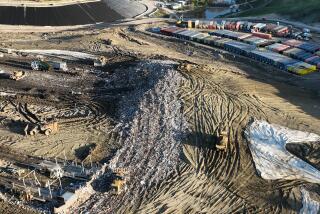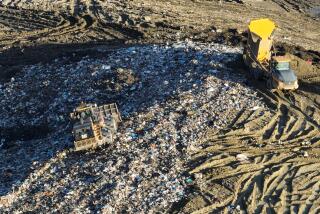Puente Hills Landfill
* Your article on the Puente Hills Landfill in the July 7 edition contained many factual errors and omissions.
The article totally ignored the legislative mandate in AB 939 for each city and county to identify 15 years of landfill capacity to safely dispose of the waste that remains after source reduction and recycling efforts. Thanks to the Board of Supervisors’ decision, 10 of those required 15 years will be available to many of the cities in Los Angeles County.
By continuing the extensive recycling and reuse programs for green waste, asphalt, tires and other materials at the Puente Hills Landfill, the supervisors have assisted cities and the county to achieve the AB 939 mandated diversion goals of 25% in 1995 and 50% in 2000. Last year alone, the materials recovery programs at the landfill recycled and reused almost1 million tons of these materials. Also approved by the supervisors at the same time as the landfill expansion, the Puente Hills materials recovery facility will recover even more recyclables.
Most of the project descriptions in the article were wrong. The landfill expansion will add approximately 100 acres--not 711--to the currently permitted fill and excavation area. The total expanded landfill will occupy only 660 acres of the site’s 1,365 acres. The maximum additional height of refuse for this 10-year permit will be 200 feet, not 500 to 600 feet. More than 700 acres of the site will remain open space; 225 acres of this area is valuable native habitat and will be preserved as such in perpetuity.
When the landfill is complete, the entire project area will revert to the County Parks and Recreation Department, with funding set aside from landfill tipping fees to develop the site into a regional park. Under this permit, the sanitation districts will be setting aside substantial funds to acquire, restore and maintain native habitat around the landfill property.
The sanitation districts have and will continue to actively support city and the county efforts to reduce waste at the source and work to develop markets for the recovered materials. About $1 million of funding and staff assistance has been provided to help develop recycling plans.
L.A. County needs to continue aggressive waste diversion programs to meet the 50% goal in 2000. But remaining waste must still be managed in safe disposal facilities. The supervisors have provided many of the county’s residents with this necessary public service.
DONALD S. NELLOR
Planning/Engineering Section Head
Solid Waste Management Department
Los Angeles County
More to Read
Sign up for Essential California
The most important California stories and recommendations in your inbox every morning.
You may occasionally receive promotional content from the Los Angeles Times.










